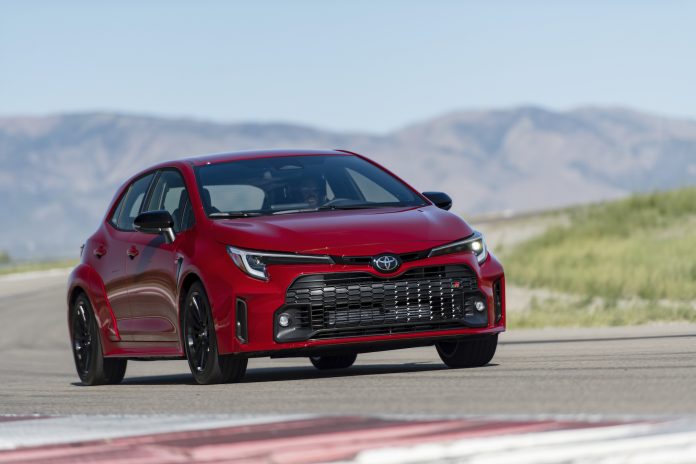Back in the 1970s and early 1980s when I was going to the drag races with my dad, the occasional flat-4-powered Volkswagen would appear among a sea of V-8 Fords and Chevys. The little rear-engined, air-cooled Beetles would buzz down the quarter-mile more slowly than most of the muscle cars that populated the track, but every once in awhile one would put up a respectable ET.
“Willpower!,” my dad would shout, in reference to the flat-4 motivation that made them so quick. Meanwhile, the muscle cars would rely mostly on big-displacement V-8s.
The 2023 Toyota Corolla GR is chock full of willpower, and it’s just as impressive as those quick drag Beetles from decades ago. Powered by a tiny 1.6-liter turbo-3, it can’t rely on displacement to make it quick. Instead, it uses a heaping helping of turbo boost and the willpower of the enthusiast Toyota engineers who turned an automotive appliance into a fun hot hatch with analog appeal.
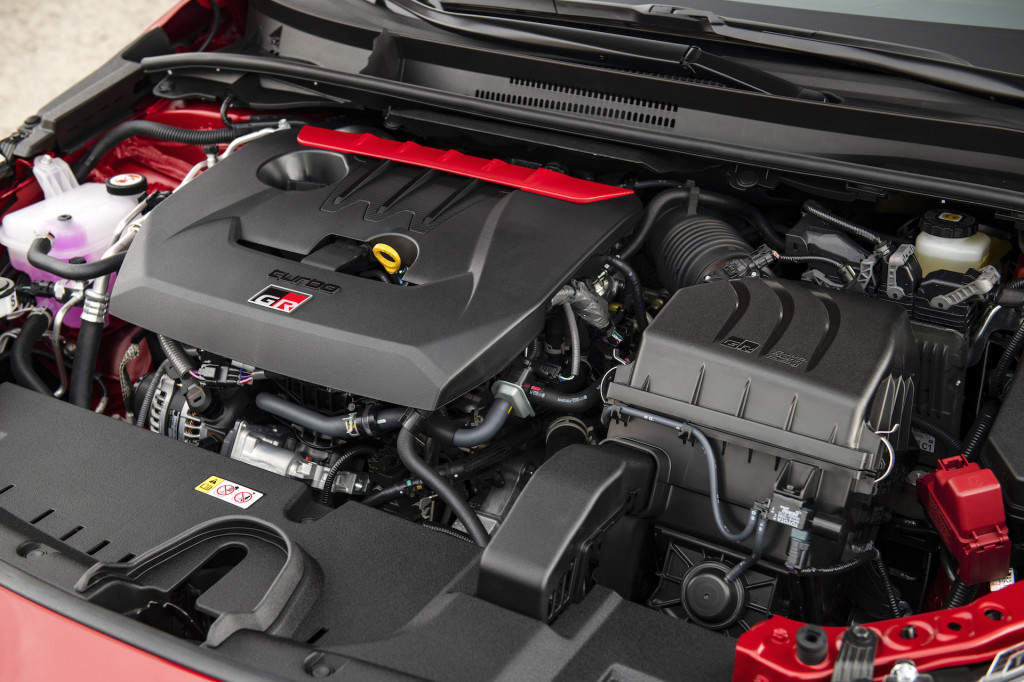
2023 Toyota GR Corolla Core
The 12-valve, dual-overhead-cam engine, known internally as G16E-GTS, is also used in the well-reviewed GR Yaris, which we don’t get in the U.S. That engine has 20.3 psi of boost and most turbo engines get about 15 psi. But in the GR Corolla, Toyota engineers shove 25.2 psi of turbo boost down the throat of the engine. In the limited-run (just 200) Morizo Edition, that increases to 26.2 psi of boost. Both versions make 300 hp, but the extra boost in the Morizo increases torque from 273 lb-ft of torque to 295 lb-ft of torque.
The engine uses some motorsport technology to wring 300 horses out of three cylinders, including a machined intake port, large diameter exhaust valves, and multi-oil jet piston cooling. It also employs both port and direct fuel injection, a system Toyota calls D-4S, to maximize power and fuel economy, though it’s not very efficient given its size, earning the GR Corolla estimated fuel economy ratings of 21 mpg city, 28 highway, 24 combined.
The G16E-GTS asks drivers to beat on it. With a single-scroll ball-bearing turbo and so much boost, peak torque takes its sweet time to arrive, hitting its plateau from 3,000-5,000 rpm. It spools up even later in the Morizo, arriving at 3,250 rpm and dropping off at 4,600 rpm. If you just drove it conservatively on the street, you might not realize it’s powerful at all—after all, we seldom exceed 3,000 rpm on our daily commutes.
On a two-plus-mile track at the Utah Motorsports Campus at Toyota’s media drive program, that means I have to rail on it to access the power. Luckily, the engine revs freely, and low gearing helps me get into the power band quickly. The power doesn’t hit hard. Instead it takes a beat or two to build, then pushes the car forward to hit 60 mph from a stop in a touch under five seconds (Toyota quotes 4.99 seconds for the Core and Circuit Edition and 4.93 seconds for the Morizo). Willpower!
The little three gives its all on the track. It’s both fun to shift and important to do so regularly to keep the engine on boil between 3,000 and 7,000 revs. A graphic tachometer flashes gray, orange, and finally red as the engine approaches, then hits, its 7,000-rpm redline. With a shorter final gear ratio, that rev band feels meatier and easier to access in the Morizo, even though the max torque band is smaller. On this 16-turn track, for instance, the Morizo requires five upshifts into fourth gear compared to an average of three in the other models because the shorter gearing makes it rev higher more often.
A 6-speed manual transmission performs those shifts. The gearbox has short, positive shifts and a clutch with moderate weight and a slightly grabby takeup point that can lead to stalls when shifting to first gear during the first few drives. Toyota calls it the iMT transmission in reference to its standard downshift rev matching that can be turned off (on is the default) via a button on the lower dash.

2023 Toyota GR Corolla Core
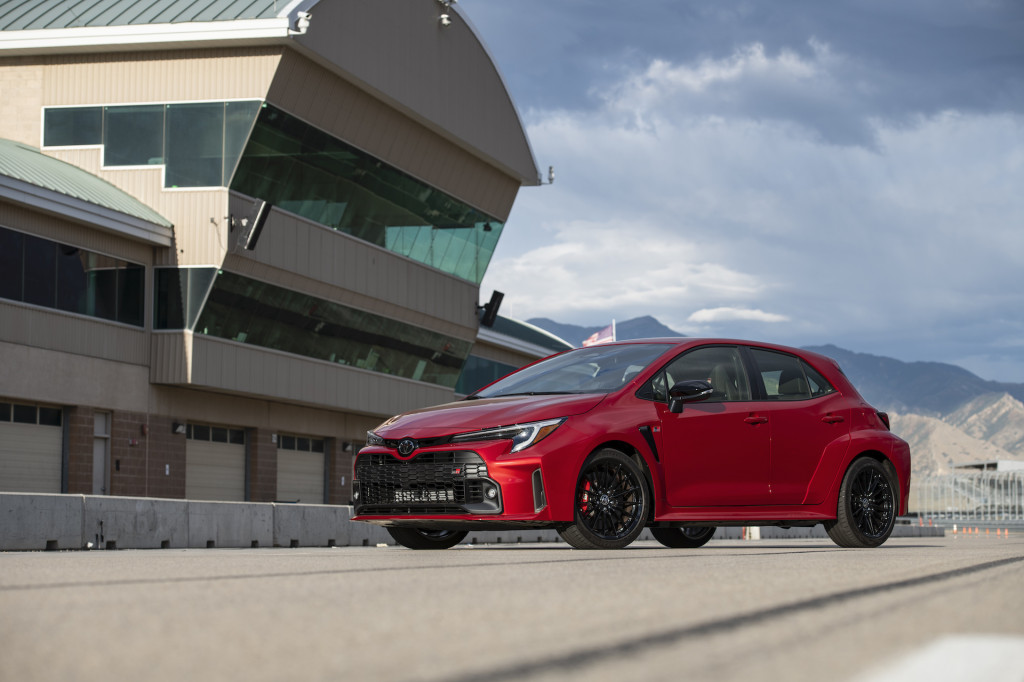
2023 Toyota GR Corolla Core
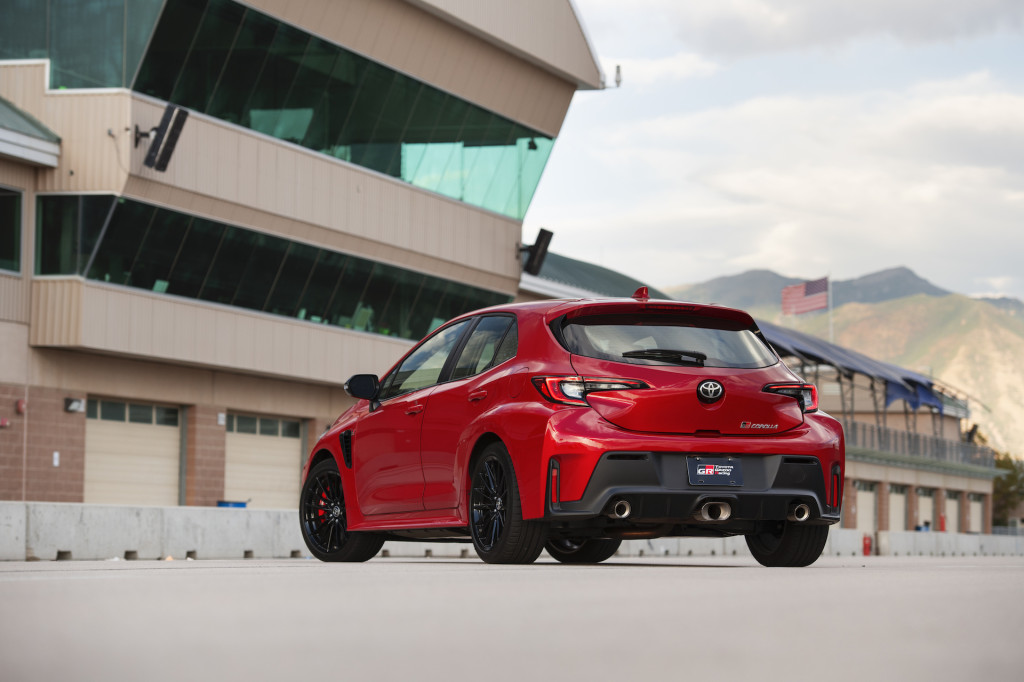
2023 Toyota GR Corolla Core
Making a manual the only choice is one sign that the GR Corolla was developed by enthusiasts for enthusiasts. Another clue? The Morizo model is named after the racing name of Toyota CEO, Akio Toyoda, who has to sign off on the driving character of every Toyota sports car before it makes it to market.
The willpower of Toyota’s enthusiast engineers doesn’t end with the engine. While the Corolla hatchback’s roots are pure economy car, the GR team buttoned it up quite well. To firm up the body structure, they added underfloor tunnel and rear wheelhouse braces, plus 349 spot welds and nine feet of bonding material. The Morizo increases the amount of bonding material to almost 20 feet, and also gets two rear cabin braces.
Every GR Corolla has a MacPherson-strut front suspension with track-tuned dampers, springs, and stabilizer bars. Double wishbones at the rear make room for the brand’s GR Four all-wheel-drive system, which was developed with an assist from Toyota’s Gazoo Racing World Rally Team. The Morizo improves the rear suspension with track-tuned coil springs and monotube shocks out back. The Circuit and Morizo both also come standard with front and rear Torsen limited-slip differentials, which are optional on the Core. A raw, forged carbon-fiber roof also helps lower the center of gravity on the Circuit and Morizo models, and the Morizo does away with a rear seat in the name of weight savings.
Every model—Core, Circuit Edition, and Morizo Edition—is available for me to test at this track drive, and all of the Core models have the $1,180 Performance Package, which includes the LSDs. For track laps, company reps recommend the setting GR Four to its Track mode, which sets a 50/50 torque split, and that’s the first mode I try in a Core model.
I’m smitten from the start. In an increasingly digital automotive world, the GR Corolla feels very analog. The GR crew increased the Corolla’s steering ratio 7% from 13.7:1 to 12.7:1 and it immediately reveals itself as quick and direct, with a lot of feel for what’s going on at the front wheels. Driving with the windows open, I can also hear what’s happening at the wheels. As I toss the car into corners, the standard 235/40R18 Michelin Pilot Sport 4 tires scrub when there’s too much steering angle, and quiet down when I unwind the wheel to balance the car. If I were blindfolded, I’d be able to tell the difference between grip and push by simply listening to the tires, but who knows what I’d hit.

2023 Toyota GR Corolla Circuit Edition

2023 Toyota GR Corolla Circuit Edition
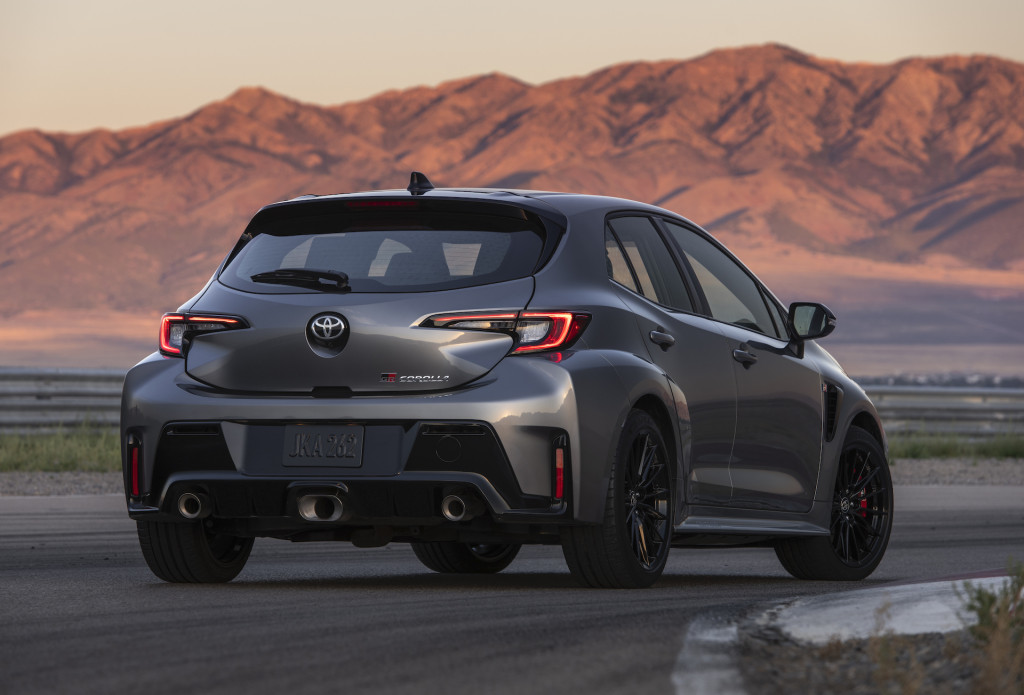
2023 Toyota GR Corolla Circuit Edition
Not that the car has a tendency to push, which would be expected for a hot hatch based on a front-wheel drive platform. Perhaps the 3-cylinder engine has something to do with that given it’s about 44 lb lighter than a comparable turbo-4, according to lead engineer Naoyuki Sakamoto.
With the base tires, if I drive too hard into a corner, the GR Corolla points in the right direction and goes into a short, controlled slide until I can get the speed under control. It then does what I tell it to do through the steering wheel, with an assist from the chosen GR Four setting. In Track mode, I can feel the front tires pulling the car through the turn. In Sport mode, which has a 30:70 front-to-rear torque ratio, the power flowing to the rear axle helps the car rotate through corners. In both cases, the LSDs make sure the power gets to the pavement, and in either mode, this rambunctious little beast is unflappable.
Those controlled slides give way to precisely carved lines in the Morizo. With its stiffer structure, a 0.2-inch lower ride height, and especially its sticker 245/40R18 Michelin Pilot Sport Cup 2 tires, the Morizo grips harder and tracks truer through the turns. It’s a pure delight, but so are the other models. Which is best for you is a matter of taste, much like it is for GR 86 buyers, who can turn their cars into drift machines with the standard all-season tires or cut faster autocross times with the available summer performance tires.
The car stops well, too. Standard 14.0-inch front rotors with 4-piston calipers and 11.7-inch rear rotors with 2-piston calipers provide strong stopping power on the track and refuse to fade during a good six hours of on and off action.
Toyota’s drive program doesn’t include a street drive, but a couple laps around the track’s ring road demonstrate that the suspension is firm but forgiving. The only possible irritant will be the car’s buzzy sound, but enthusiasts will find it more fun than frustrating. The engine has a three-pipe exhaust system that closes the center pipe at 20 mph for a more subdued experience. It opens back up at 4,500 rpm to supply the buzzy racket drivers likely want that high in the rev range.
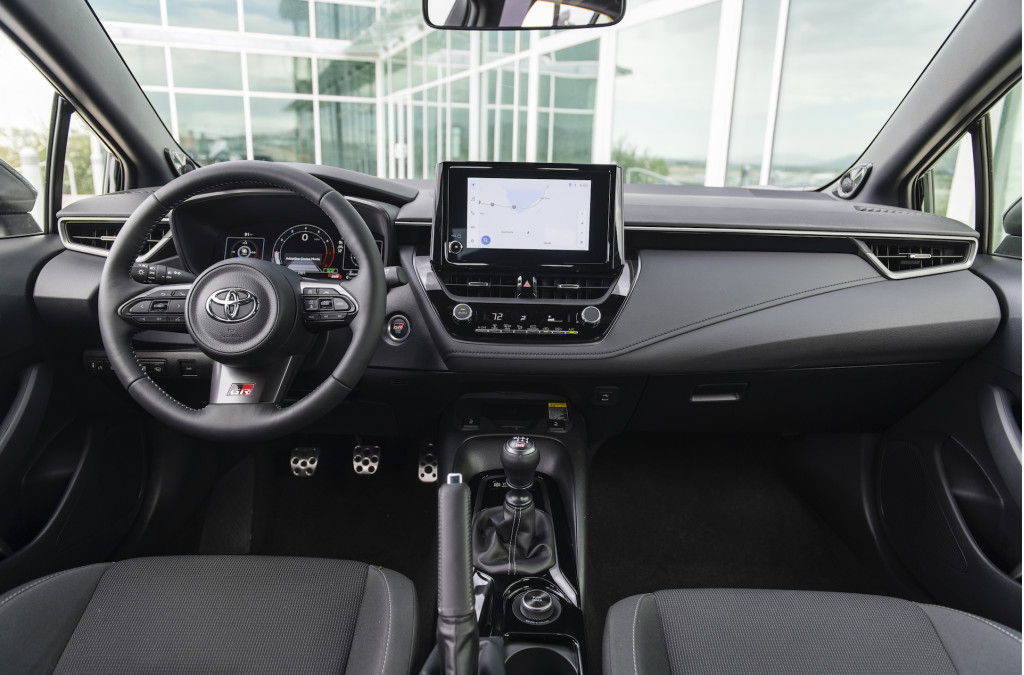
2023 Toyota GR Corolla
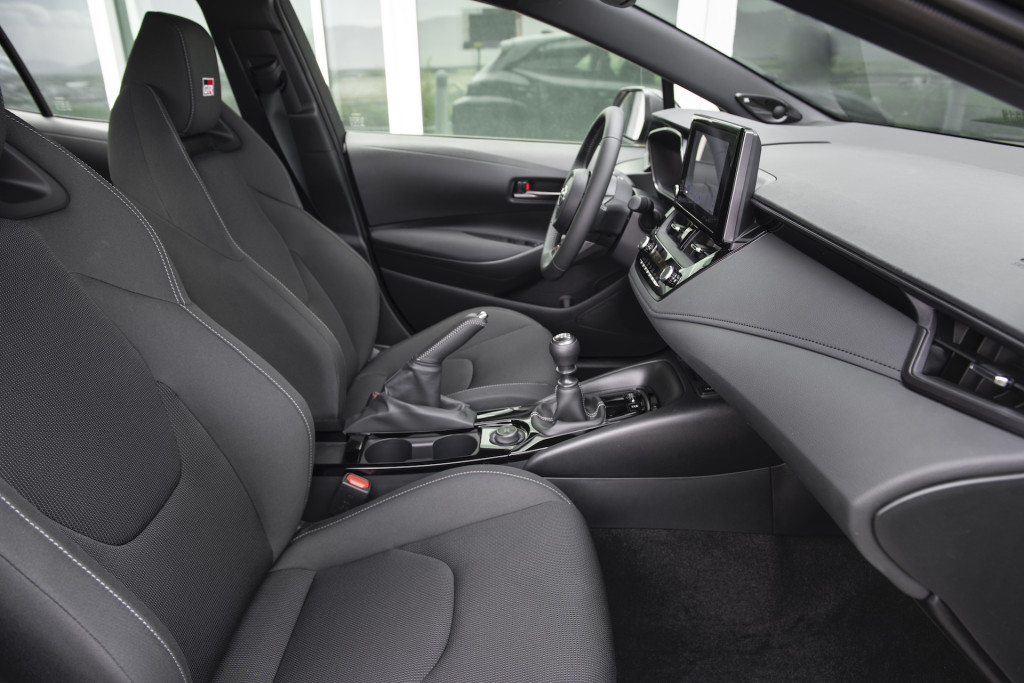
2023 Toyota GR Corolla
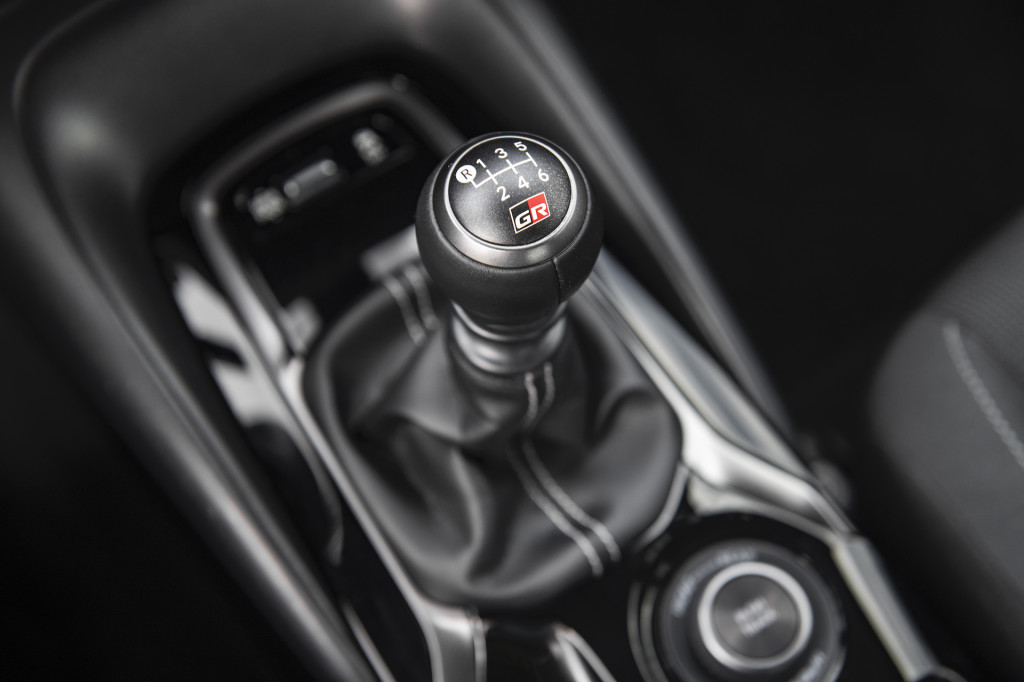
2023 Toyota GR Corolla
The GR Corolla’s cockpit doesn’t quite match the car’s price point, which is $36,995 for the base Core model. It’s plasticky and clearly has economy car roots, but it does come standard with supportive fabric sport seats, silver contrast stitching, aluminum pedals, an 8.0-inch infotainment touchscreen, and a 12.3-inch digital instrument cluster with available readouts for the GR Four drive mode, turbo boost pressure, and g forces. The $43,995 Circuit Edition gets synthetic suede and synthetic leather upholstery with red contrast stitching, heated front seats, a heated steering wheel, and wireless smartphone charging. The $50,995 Morizo Edition has synthetic suede wrap on the shift knob and steering wheel and the rear seat delete.
No GR Corolla will be mistaken for a pedestrian base model, thanks to widened body panels to cover the wider wheels and tires, attractive 18-inch wheels, a hood bulge on all but the Core model, more front end cooling ducts, a rear spoiler, the carbon-fiber roof, and the hatchback body style itself. Instead of an automotive appliance, they’ll see a rowdy hot hatch with an attitude, and they’ll be right. Should they take it for a test drive, especially on a track, they’ll also discover it has the willpower to match its outward attitude.
Toyota paid for airfare, lodging, and track time for Motor Authority to have a ball tossing the GR Corolla through corners and bring you this firsthand report.

